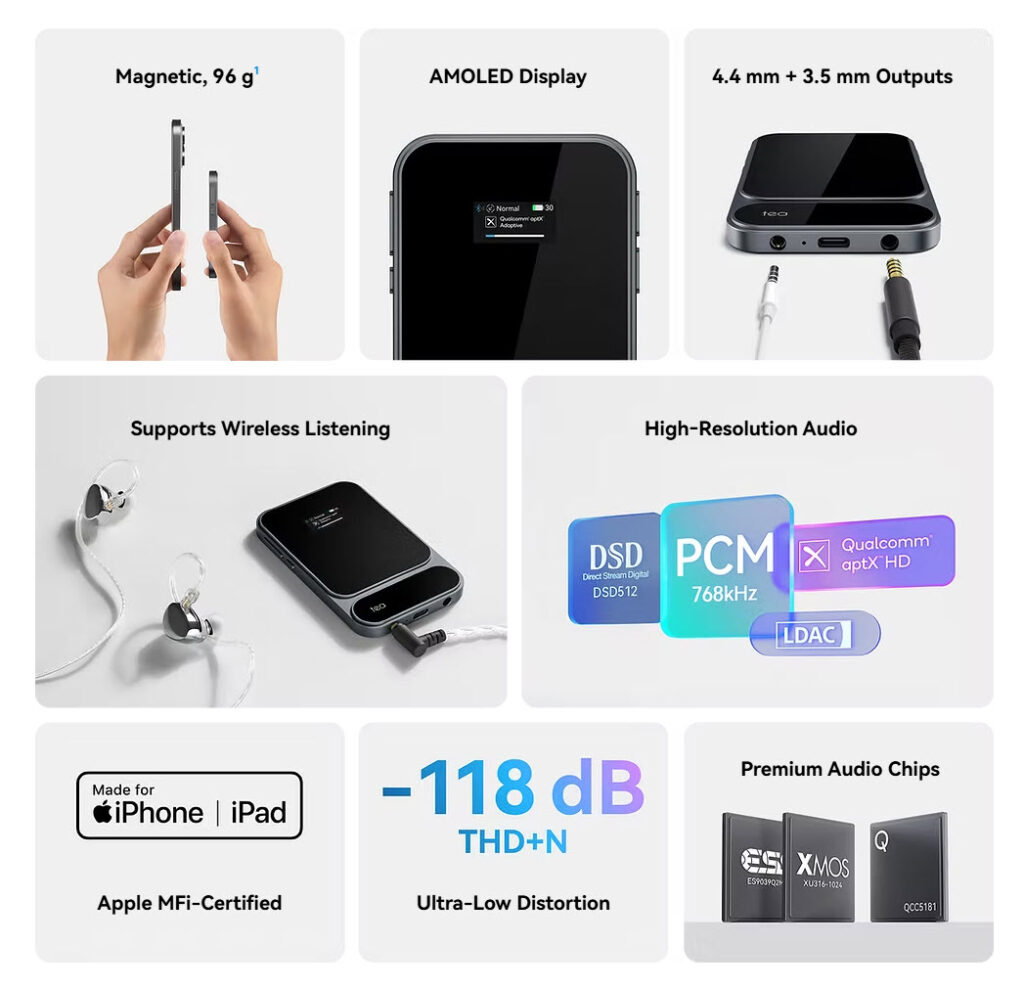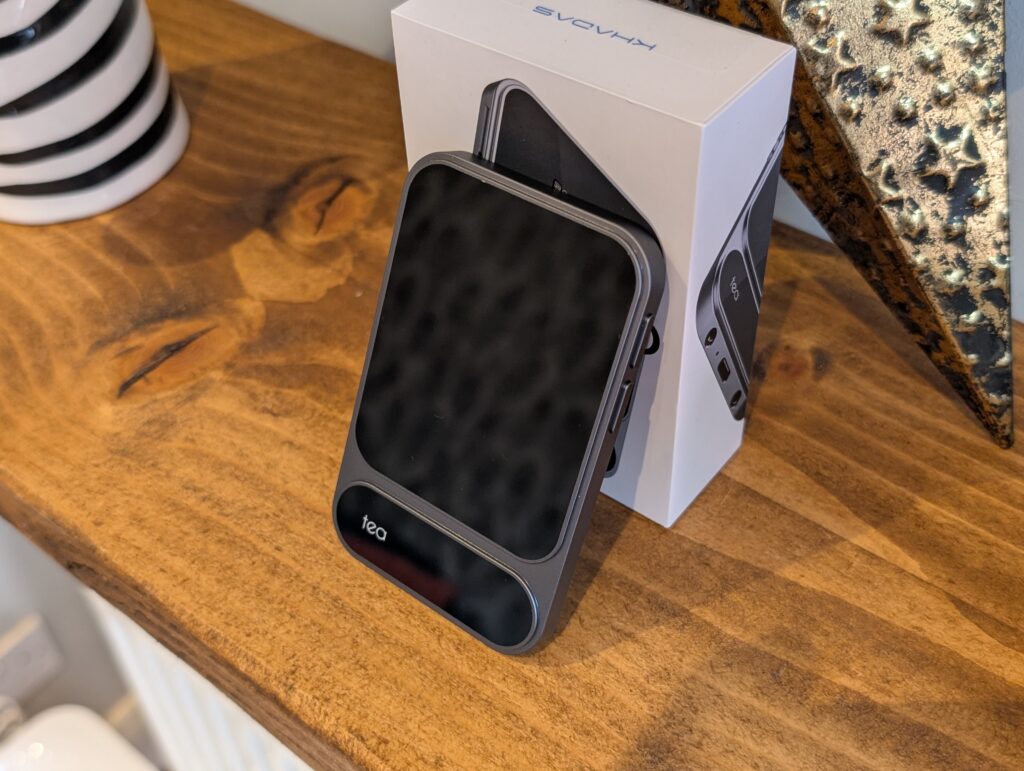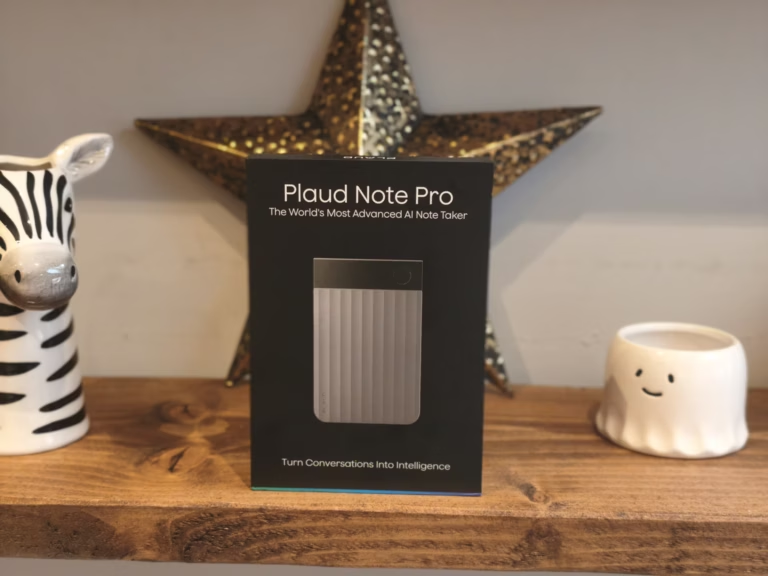Khadas Tea Pro Portable DAC Headphone Amplifier Review
A more details review of the Khadas Tea Pro is available on mightygadget.co.uk
My brother Ted reviewed the original Khadas Tea nearly three years ago, highlighting its warm bass bias and frustrating lack of a companion app. While I personally prefer warmer sound (high-pitched noises are my nemesis), the limited customisations clearly held it back. Khadas eventually launched the Audio app over a year later, but the damage was done.
The Tea Pro addresses those shortcomings head-on and adds a raft of new features that transform it from a niche product into a genuinely competitive portable DAC.
What’s Actually Improved

The spec sheet tells the story. You’re getting an ESS ES9039Q2M DAC (versus the ES9281ACPRO), a Qualcomm QCC5181 Bluetooth chipset (up from QCC5125), and an XMOS XU316-1024 USB controller. In practical terms: PCM support jumps from 384 kHz to 768 kHz, DSD from 256 to 512, and Bluetooth moves from 5.1 to 5.4 with aptX Adaptive support.
The measured performance backs this up. THD+N sits at 0.000126% (-118 dB) with no load, and SNR hits 122 dB on the balanced output. Those aren’t just impressive numbers on paper—you can hear the difference.
The physical changes are just as significant. The 0.95-inch AMOLED display (120 x 240 RGB) shows battery life, connection mode, audio format, and sample rate. You also get a 4.4mm balanced output alongside the 3.5mm jack, delivering up to 5.0 Vrms and 180 mW into 16.5 ohms. The 3.5mm manages 2.5 Vrms and 100 mW.
The MagSafe compatibility remains, which is brilliant for iPhone users. At 7.85mm thick and 96g, it genuinely disappears when magnetically attached to your phone. The CNC-machined aluminium chassis with Gorilla Glass 3 and leather back feels premium, though the glossy surfaces are fingerprint magnets.
Design Frustrations

I have to be honest about the button layout—it’s genuinely unintuitive. You get two volume buttons on the right, then two on the left: one larger, one smaller. I assumed the larger one was a rocker and the smaller was power. Wrong. The larger one is power, the smaller is menu. I had to consult the manual, which is frustrating on a £200 device.
Audio Performance: Wired vs Wireless
Testing with high-resolution DSD and FLAC files from OPPO’s library revealed the expected hierarchy. Over Bluetooth, you’re capped at PCM 96 kHz/24-bit, but USB with UAC2.0 delivers the full PCM 768 kHz or DSD512 capability.
The difference between wired and wireless isn’t subtle. USB-C connection provides a significant improvement in clarity, detail retrieval, and dynamic range. The soundstage is wider, instrument separation is more distinct, and there’s an immediacy that Bluetooth simply cannot match. Bluetooth introduces a slight veiling and more distant presentation—perfectly adequate for casual listening on the go, but for critical listening, wired is the clear choice.
The balanced 4.4mm output is a standout. It provides more power and a lower noise floor compared to the 3.5mm jack, ideal for higher-impedance headphones or sensitive IEMs. You hear it as a blacker background, allowing micro-details to emerge with greater control over the drivers.
Codec Comparison
Testing various Bluetooth codecs revealed the expected differences:
- SBC: Basic quality, noticeable compression
- AAC: Improved over SBC, good for iPhone users
- aptX: Better than AAC, more detailed
- aptX HD: Noticeable improvement in resolution
- LDAC: Best wireless quality, approaching wired performance
- aptX Adaptive: Variable quality based on connection stability
The aptX Adaptive inclusion is welcome, adjusting bitrate based on connection conditions for more consistent performance than fixed-bitrate codecs.
App and Controls
The Khadas Audio app (iOS, Android, macOS, Windows) offers seven EQ presets and a ten-band graphic equaliser with gain adjustable from -12 dB to +12 dB per band. The on-device controls via the screen mean you’re not always dependent on the app, though the app can sometimes be slow to reflect device changes.
For Windows, you’ll need to install drivers from Khadas’ downloads page to adjust bit rate and sampling rate—it’s not quite plug-and-play. Android users get full app functionality, and my Pixel 9 Pro XL detected it as a wired headphone when plugged in.
Battery Life
The 2100 mAh battery delivers the quoted 11 hours of Bluetooth playback and 8 hours of wired USB use in real-world testing, though this varies with volume, gain settings, and codec choice. It’s sufficient for a full day, and pass-through charging works, albeit with some heat generation. Full charge takes approximately two hours.
Price and Alternatives
Here’s where it gets interesting. The Tea Pro has an RRP of $199 (£199 in the UK), whilst the older Tea is £100 on Amazon UK.
The FiiO BTR15 (£115) and BTR17 (£180) are probably the closest competitors, working over Bluetooth or USB-C, though neither offers magnetic attachment. The iFi GO blu (£199) takes a different approach with analogue warmth at the same price point.
The Qudelix-5K at £101 on Amazon is possibly the best value option—extremely well reviewed and significantly cheaper, though it lacks the MagSafe integration and balanced output.
Verdict
The Tea Pro is a substantial upgrade that addresses the original’s shortcomings. The colour display, balanced 4.4mm output, improved DAC chipset, and Bluetooth 5.4 with aptX Adaptive transform it into a highly competitive portable audio solution.
For iPhone users frustrated by limited high-resolution codec support, this is arguably one of the best solutions available. It bypasses the iPhone’s Bluetooth limitations when wired and enhances wireless listening when necessary. For Android and computer users, it’s an excellent, highly portable DAC/amp with a comprehensive feature set.
The minor irritations—unintuitive button layout, fingerprint-prone surfaces, occasionally sluggish app—don’t fundamentally undermine what is otherwise a top-tier portable audio device. The audio performance is exceptional for the size, the build quality is premium, and the MagSafe integration is genuinely clever.
Is it worth the price premium over the original Tea or the Qudelix-5K? If you want the balanced output, superior DAC performance, and seamless iPhone integration, yes. If you’re purely after value, the alternatives deserve serious consideration.





